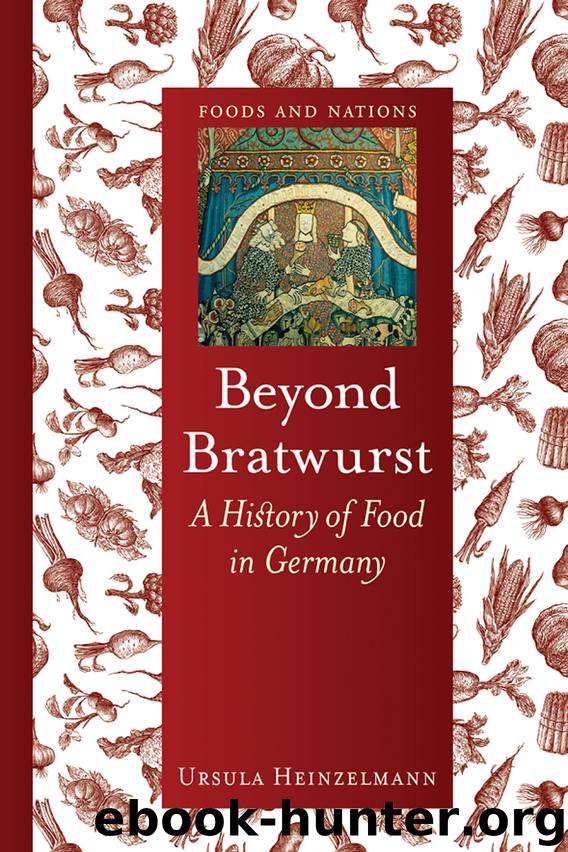Beyond Bratwurst by Ursula Heinzelmann

Author:Ursula Heinzelmann
Language: eng
Format: epub
Publisher: Reaktion Books
Published: 2017-09-05T04:00:00+00:00
The introduction and expansion of the railway system was a key factor in the movement of people as well as foodstuffs throughout the period. Within a few decades people embraced the new mobility and the distribution of perishable foodstuffs increased markedly. Instead of Postwartestuben, waiting rooms along the old postal lines, Bahnhofsrestaurants now catered to travellers in the larger train stations. Soon first-class passengers could order a warm meal at the station to be served at their seat on the train, and in 1880 the first dining car on the European continent was introduced on the line linking Berlin to Frankfurt am Main. When Baedeker, the German equivalent of Murray’s red books for English travellers (and a follow-up of the Münster Montaigne missed on his trip in the 1580s), was first published in 1835, it was advertised as a handbook for fast travellers. Cultural tourism was on the rise. In 1816 the first steamship on the Rhine was English, but eleven years later it was joined by a German equivalent. The idea of travelling out of curiosity or for relaxation or entertainment was immediately attractive to Germans. A slim cookbook, Junggesellen- und Touristen-Kochbuch, published in 1896 and aimed at bachelors, included travellers in the title. Just over half a century after the first railway line opened to passengers, overnight express trains were taken for granted. In towns and cities the number of travellers prepared to pay for accommodation saw taverns and inns replaced by hotels and Höfe, courts. Many of these were endowed with seemingly aristocratic names and initially were reserved for men. Towards the end of the century establishments which offered nothing more than a set menu were considered outmoded and replaced by large hotels with restaurants, many of them financed by shareholders. These luxurious establishments offered travellers more modern amenities than they could afford at home and were greeted with great enthusiasm.
Before 1871 most places – like Gebrüder Habel, opened in 1779 on Unter den Linden in Berlin – had been more solidly bourgeois than openly extravagant. After that, however, the restaurant scene fundamentally changed. William I had French chefs but was comparatively modest at table, whereas his chancellor Bismarck was a gourmet who loved large amounts of good food. In 1878, on the occasion of the Berlin congress, the British delegation noted somewhat disparagingly: ‘Prince Bismarck, with one hand full of cherries, and the other of shrimps, eaten alternately, complains he cannot sleep and must go to Kissingen [to take the waters].’20
From the economic boom of the so-called founding years (mainly based on the substantial French reparation payments after the Franco–Prussian war of 1870/71) and the pompous lifestyle favoured by William II all kinds of new hotels and restaurants emerged, anticipating the excesses of the 1920s. In Berlin in late 1877, the imposing Vienna-style Café Bauer opened opposite Café Kranzler. It was lavishly decorated by well-known artists. Seven years later it was the city’s first restaurant with electric lighting. It offered 600 newspapers and magazines as well as a separate room for unaccompanied ladies.
Download
This site does not store any files on its server. We only index and link to content provided by other sites. Please contact the content providers to delete copyright contents if any and email us, we'll remove relevant links or contents immediately.
Ottolenghi Simple by Yotam Ottolenghi(3428)
BraveTart by Stella Parks(3310)
Trullo by Tim Siadatan(3305)
Bake with Anna Olson by Anna Olson(3280)
Harry Potter and the Prisoner of Azkaban (Book 3) by J. K. Rowling(3115)
Nigella Bites (Nigella Collection) by Nigella Lawson(3096)
Tom Kerridge's Dopamine Diet: My low-carb, stay-happy way to lose weight by Kerridge Tom(2953)
Best of Jane Grigson by Jane Grigson(2871)
Classic by Mary Berry(2838)
Solo Food by Janneke Vreugdenhil(2825)
Sweet by Ottolenghi Yotam & Goh Helen(2810)
Ottolenghi - The Cookbook by Yotam Ottolenghi(2739)
Flavor Flours by Alice Medrich(2648)
Coffee for One by KJ Fallon(2423)
Hot Sauce Nation by Denver Nicks(2375)
Veg by Jamie Oliver(2308)
Claridge's: The Cookbook by Nail Martyn & Erickson Meredith(2259)
Chefs & Company: 75 Top Chefs Share More Than 180 Recipes To Wow Last-Minute Guests by Isabella Maria(1942)
Lose Weight for Good by Tom Kerridge(1839)
